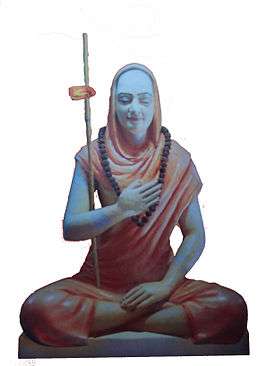Cause and effect in Advaita Vedanta

| Part of a series on |
| Advaita |
|---|
 |
|
Origins Hinduism Buddhism |
|
Schools Vedanta
Shaivism/Tantra/Nath Neo-Advaita/Nondualism |
|
Teachings Classical Advaita vedanta
Kashmir Shaivism |
|
Practices Classical Advaita Vedanta
Shaivism/Tantra/Nath Neo-Vedanta |
|
Scriptures Advaita Vedanta
Neo-Vedanta Inchegeri Sampradaya |
|
Teachers Tradional Advaita Vedanta
Modern Advaita Vedanta Shaivism/Tantra/Nath Neo-Advaita Other |
|
Monasteries and Orders Classical Advaita Vedanta
Modern Advaita Vedanta Neo-Vedanta |
|
Scholarship
|
|
Categories
|
Cause (kāraṇa) and effect (kārya) are an important topic in all schools of Vedanta.
Creation of the world
All schools of Vedanta subscribe to the theory of Satkāryavāda,[web 1] which means that the effect is pre-existent in the cause. It is explained in a central passage at Chāndogya Upaniṣad 6.1.4-5, where the sage Aruni explains the workings of causality to his son, Śvetaketu, using the example of the relation of clay to a pot:
It is like this, son. By means of just one lump of clay one would perceive everything made of clay—the transformation is a verbal handle, a name—while the reality is just this: "It's clay." It is like this, son. By means of just one copper trinket one would perceive everything made of copper—the transformation is a verbal handle, a name—while the reality is just this: "It's copper."[web 1]
But there are two different views on the status of the "effect", that is, the world. Most schools of Vedanta,[1][web 1] as well as Samkhya,[web 1] support Parinamavada, the idea that the world is a real transformation (parinama) of Brahman.[1] According to Nicholson, "the Brahma Sutras also espouse the realist Parinamavada position, which appears to have been the view most common among early Vedantins".[1] Adi Shankara and Advaita Vedanta adheres to the other view, Vivartavada, which says that the effect, the world, is merely an unreal (vivarta) transformation of its cause, Brahman:
[A]lthough Brahman seems to undergo a transformation, in fact no real change takes place. The myriad of beings are essentially unreal, as the only real being is Brahman, that ultimate reality which is unborn, unchanging, and entirely without parts.[1]
Nimitta kāraṇa and Upādāna kāraṇa
Two sorts of causes are recognised:
- Nimitta kāraṇa, the instrumental cause. A potter is the instrumental cause when he makes a pot.
- Upādāna kāraṇa, the material cause. The clay is the material cause of the pot.
Brahman is the instrumental cause of existence:[note 1]
That Lord has created all the forms and is calling them by their names (Taitiiriya Aranyaka 3.12.7)[note 2]
He thought, "Let Me create the worlds" (Aitareya Upanishad 1.1.1)[web 2][note 3]
But Brahman is also the material cause:
Dear boy, just as through a single clod of clay all that is made of clay would become known, for all modifications is but name based upon words and the clay alone is real (Chandogya Upanishad 6.1.4[web 3])[note 4]
(He thought) Let me be many, let me be born (Taittiriya Upanishad 2.6.4)[web 4][note 5]
Thus, based on these and other statements found in the Vedas, Advaita concludes that Brahman is both the instrumental cause and the material cause.
kārya-kāraṇa ananyatva
Advaita states that effect (kārya) is non-different from cause (kāraṇa), but the cause is different from the effect:
- kārya is not different from kāraṇa; however kāraṇa is different from kārya
This principle is called kārya-kāraṇa ananyatva.
Effect is not different from cause
When the cause is destroyed, the effect will no longer exist. For example, cotton cloth is the effect of the cotton threads, which is the material cause. Without threads there will be no cotton cloth. Without cotton there will be no thread.
In the Brahmasūtra-Bhāṣya 2.1.9 Adi Shankara describes this as follows:
Despite the non-difference of cause and effect, the effect has its self in the cause but not the cause in the effect.
The effect is of the nature of the cause and not the cause the nature of the effect.
Therefore the qualities of the effect cannot touch the cause.[web 5][note 6]
Cause is different from effect
The cause is different from the effect. For example, the reflection of the gold ornament seen in the mirror is only the form of the ornament. It is not the ornament itself, since the reflection itself is not the gold.
Brahman is different from the world
This reasoning implies that the world is not different from Brahman, but Brahman is different from the world:
All names and forms are real when seen with the Sat (Brahman) but are false when seen independent of Brahman.[note 7]
See also
Notes
- ↑ The following statements are not to be taken literally, as Brahman does not 'think' nor is the 'creator' or 'God', rather Saguna-Brahman (creator God) is associated with all that.
- ↑ sarvāṇi rūpāṇi vicitya dhīraḥ, nāmāni kṛtvābhivadan yadāste
- ↑ sa īkṣata lokānnu sṛjā iti
- ↑ yathā somya! ekena mṛtpinḍena sarvaṃ mṛnmayaṃ vijñātaṃ syād vācāraṃbhaṇaṃ vikāro nāmadheyaṃ mṛttiketyeva satyaṃ
- ↑ so'kāmayata bahu syāṃ prajāyeyeti
- ↑ ananyatve'pi kāryakāraṇayoḥ kāryasya kāraṇātmatvaṃ na tu kāraṇasya kāryātmatvaṃ
- ↑ sarvaṃ ca nāmarūpādi sadātmanaiva satyaṃ vikārajātaṃ svatastu anṛtameva Adi Shankara, Chāṃdogya Upaniṣad Bhāṣya, commentary on the Chandogya Upanishad, 6.3.2
References
- 1 2 3 4 Nicholson 2010, p. 27.
Sources
Published sources
- Nicholson, Andrew J. (2010), Unifying Hinduism: Philosophy and Identity in Indian Intellectual History, Columbia University Press
Web-sources
- 1 2 3 4 Internet Encyclopedia of Philosophy, Bhedābheda Vedānta
- ↑ Celextel Enterprises Pvt. Ltd. (11 April 2010). "Aitareya Upanishad at". Celextel.org. Archived from the original on March 9, 2007. Retrieved 2011-06-10.
- ↑ "Chandogya Upanishad". Archived from the original on 24 October 2009.
- ↑ "Taittiriya Upanishad". Archived from the original on 24 October 2009.
- ↑ "Brahma Sutras by Swami Sivananda". Swami-krishnananda.org. Archived from the original on 12 June 2011. Retrieved 2011-06-10.